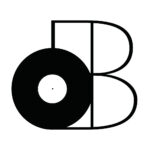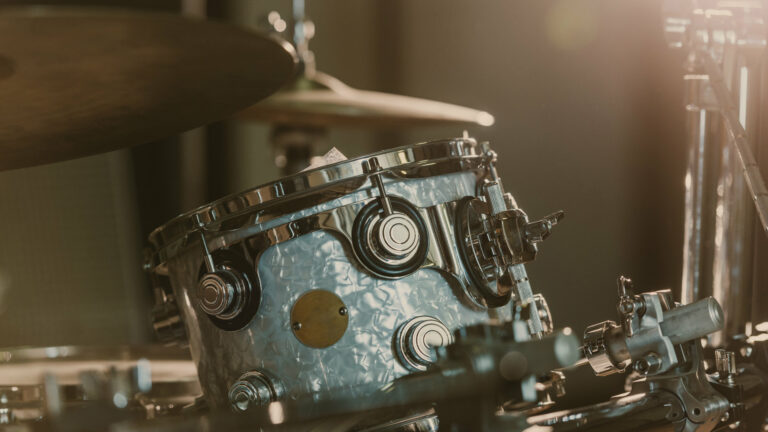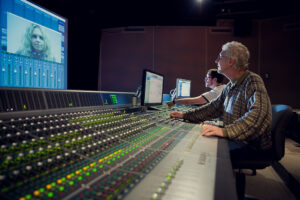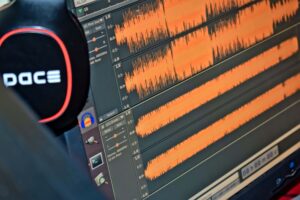It’s even more important to learn how to tune your drums for recording than it is for stage-use. The advantage with live performances is that your audience is usually pretty far away from your drum kit and has many other “distractions” to deal with. Now, that doesn’t mean that you shouldn’t tune your drums for stage-use, but it’s even more important for the recording studio because microphones HEAR EVERYTHING.
Although you’ll be working in controllable (or MORE controllable) environments, learning how to tune drums for recording can be quite the challenge. First of all, you’ll need to be much more specific about the specific pitch each drum is tuned to. Did you think that drums were somehow exempt from musical pitch/harmony? If your drum kit’s tuning doesn’t compliment the song you’re working on, it won’t sound as powerful. That means we’ll not only need to consider how the drums are tuned relative to one another, but how the drum kit is tuned relative to the song’s key (or tonal centre(s)). What about editing though… Is it possible to modify drum tuning in post-production? You’ll know the answer to all those questions by the end of this article and more, so let’s get started!
- Drum tuning isn’t two-dimensional, it’s three-dimensional
- Tuning drums to specific pitches for studio recording
- Tuning drums using the right type of tuner
- Editing drum tuning digitally in post-production
- Using DrumTune Pro to tune your drums for recording
Drum tuning isn’t two-dimensional, it’s three-dimensional
What does that even mean? It means that tuning drums isn’t as simple as tuning other pitched instruments like guitar, piano, etc… It’s actually kind of scientific/mathematical!
That being said, it’ll be much more difficult to control the outcome without the proper tools.
We’ll be talking about tools later but for now, let’s start by understanding how drum tuning works. I spent many hours researching the subject because I wanted definite answers on how to tune my drum kit. I wasn’t satisfied with the “tune it until it sounds good” answer I got from most.
The reason that answer has become commonplace is because not many have actually put in the hours into understanding how drum tuning works.
Tuning “by ear” may get you some decent results, but you have no idea how you got there…
That kind of ignorance will become apparent when someone asks you to tune your drums in a specific way/key. YES, some music producers are very specific about drum tuning.
The first thing we need to understand about drums is that we’re working with TWO vibrating membranes to achieve our sound. You can think of it like addition/subtraction.
If that makes you think of sympathetic vibration, it’s not quite the same concept (it’s close though).
The second thing you’ll want to remember is that the centre of your drum produces what we refer to as the “fundamental” while the outer edges produce the pitches associated with the respective lugs (the areas you tighten/loosen to to tune your drum).
The third point I want to drive home is that your drum heads DON’T necessarily need to be tuned to the same pitch. It may actually be more desirable to tune them to different pitches, but more on that coming up.
If all of this sounds overwhelming… GOOD! The truth is it can be.
I got pretty frustrated when I realized how difficult it could be to tune drums until I found a tool that made my life WAY simpler. If you keep reading, you’ll find out all about that tool.
You’ll also be much less overwhelmed/stressed out about this whole issue (hopefully).
So, let’s start talking about specific tunings for your drum kit.
Tuning drums to specific pitches for studio recording
Some say that the drum kit MUST be tuned to the key of the song… Some say that it doesn’t really matter what key the drums are tuned to. I personally believe that IT DOES MATTER, but that it doesn’t necessarily need to be tuned to the key of the song.
Every song is unique and should be treated as such.
I also KNOW for a fact that the global pitch of the drum kit can be modified in post-production (more on that coming up).
That being said, I prioritize TWO things when it comes to drum tuning:
- The actual timbre/tone of each individual drum
- The tuning scheme for the entire kit
For example, you can get your kick drum to sound the pitch “C” using many different tunings that will alter the overall timbre/tone and feel. I’ll be explaining why shortly.
You can also have your drum kit tuned to different intervals. For example, you can have your toms tuned in minor 6ths from each other (ex.: rack tom = G2, floor tom = B1).
After reading this, you’re probably wondering how one drum can have different sounds while keeping the same pitch…
Remember when I said that drum tuning was similar to addition/subtraction?
Let’s say that “0 + 0” means that both heads (batter/resonant) are tuned the same. The answer to that equation is “0”, but it’s also the same for “-1 + 1” or even “-2 + 2”.
If “0” is our reference pitch, you can see that there are many ways to get the same pitch.
However, the resulting timbre/tone will be different. In fact, the way the drum behaves itself will be much more pronounced depending on how extreme you get.
By tuning one head higher/lower than the other, you’ll be decreasing sustain and also creating what we refer to as “detune” (when the drum’s pitch shifts up or down during the decay phase).
Does that sound complicated? Well, we haven’t even considered pitches that would be represented by values other than “0” (ex.: “-1 + 0”, “0 + 2”, etc…).
So how does one keep track of all of these possibilities?
Tuning drums using the right type of tuner
If you were thinking of using a guitar tuner to tune your drums… Think again! The type of tool we’ll be needing to tune our drums is going to need to be both a tuner and a calculator.
It should also keep track of all the different possibilities and recommend some!
Luckily for us, such a tool has been created. It can be found on the App Store/Play Store under the name DrumTune Pro. It’s basically the “Pokedex” for drummers (if you didn’t get my Pokemon reference, shame on you).
I won’t get into the details of how DrumTune Pro actually works today.
I just want you to know that it’ll recommend how to tune your drums based on the TWO criteria I mentioned in the previous section which are…
- Tone/Timbre
- Relative/Intervallic Tuning
You basically feed the app this information and it tells you which frequency each head (batter/resonant) needs to be tuned to. It’s really precise and actually allows you to tune each individual lug to perfection!
It’s even possible to store presets and to create your own tuning schemes!
There’s a 7-day free trial available, so I encourage you to try it out for yourself.
There aren’t any other tools on the market that provide this kind of functionality (trust me, I checked) and it’s WAY underpriced in my opinion. There’s no excuse not to purchase the full version once you realize how much time and hassle it’ll save you.
Even if you have no idea which pitches you’d like to tune your drums to, it even has pre-made presets for you based on genre so there’s no excuse.
The creator is really passionate about his tool and loves to help drummers reach the same level of enlightenment I’ve recently achieved (thanks Bram).
Editing drum tuning digitally in post-production
One of the last points I’d like to cover is how to tune your drums in post-production. If you were wondering how that could be achieved, we’ll be learning the DOs and the DON’Ts.
First of all, I’m all about MINOR adjustments.
What I mean is that it won’t sound great if you digitally tune your drums more than a few tones up and/or down. It’s also not advisable to digitally tune your drums individually.
That means that using microphones for each drum won’t grant you unlimited possibilities.
The phenomenon known as “microphone-bleed” will create problems. For example, tuning your kick drum down one semitone on its dedicated microphone will make it sound out of tune with the kick drum you hear in the room/overhead microphones.
That’s why I only recommend digitally tuning your drums GLOBALLY.
That means if one track is tuned up one semitone, all of them should follow suit.
These types of tricks can come in-handy down the road if ever the producer suddenly decides to change the key of the song or realizes that the kick drum should’ve been tuned to “D” instead of “C”.
If you did your homework by making sure the rest of the drums sound good relative to one another, you’ll be preserving that effect even after the transposition.
The same applies if the entire kit was slightly out-of-tune during the recording session.
I also encourage you to experiment with this technique because as I said earlier… It doesn’t really matter if the drum is in the same “key” as the song. You may get some interesting results by tuning the entire kit slightly sharp/flat.
Although your drum kit is pitched/tuned, it’s still more of a percussive texture in the context of the mix.
Using DrumTune Pro to tune your drums for recording
I forgot to mention that DrumTune Pro is also suitable to use on-stage! Your specialized drum tuner will always be available because you bring your phone with you everywhere, don’t you?
It’s much more powerful than your typical guitar tuner, you’ll see.
I honestly don’t know how drummers have been tuning their drums before this app (it’s been around for almost 7 years). It just goes to show you that even with all the videos/tutorials on the internet, you still need to be careful.
It doesn’t mean that because someone tells you how to do something that they necessarily know what they’re talking about.
That being said, you don’t have to listen to me either!
However, I hope you see how far I’ve gone to find the answers I was looking for and that there are other individuals like Bram, the creator of DrumTune Pro, who will stop at nothing to stimulate the evolution of our musical understanding.
Tuning drums is three-dimensional, so we need the right tool for the job.
If you’ve been tuning your drums without DrumTune Pro, I’m curious… How have you been getting by up until now? I’m actually a guitarist first (even if I play many instruments), so I’m always looking to learn more about my secondary instruments.
Feel free to leave your comments and/or questions down below and I’ll get back to you as soon as possible. You can also schedule a 1-on-1 consultation with me if you prefer. Thanks for reading, I hope it made drum tuning less overwhelming for you.
Sources








